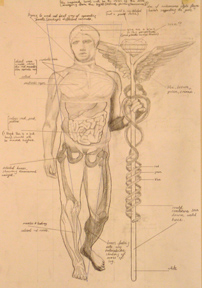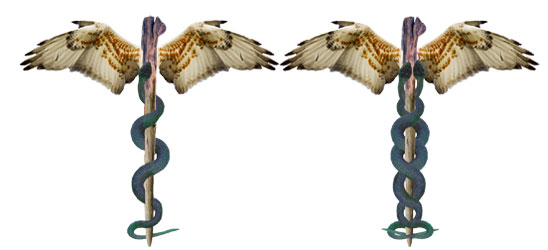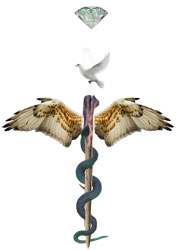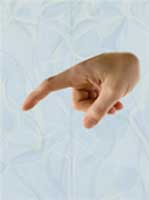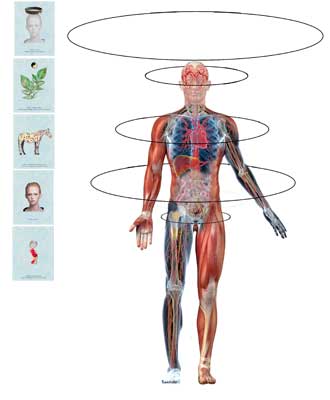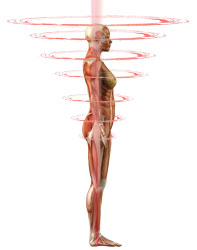A symbolic representation of spiritual truths, growth, and healing
“The essence of InnerDialogue, whether applying it in life, relationships, work or the practice of InnerDialogue is based on understanding the Caduceus, the ancient symbol for medicine.
”
The caduceus has turned up in many varied disguises over the millennia, since pre-Babylonian times. In the CE era the fabled wand or rod, the caduceus, was portrayed as being carried by Hermes in Greek myths as a psychopomp (carrier of the dead to the underworld) and by Mercury in Roman mythology as a messenger of the gods (a muse). A modified caduceus is associated with Aesculapius, the Greek god of healing. His symbol was a rough-hewn staff with a single snake entwining it.
In the classical depiction of the symbol, a staff or rod has a pair of snakes entwined around it and is topped by a pair of wings. Some other depictions carry only a single snake around the central staff and wings, indicating the singularity of the snake as representative of inner life (symbolic of an inherent vibration) rather than the duality of the paired snakes.
We can view this symbol as a triad of components. We have used simple human terms to infer or imbed the qualities inherent in this symbol. The three parts could be summarized as three innate human qualities, but they also contain a much larger grander idea, that of a spiritual reality:
[1] a single line: integrity (the staff),
[2] a wavy or curved line(s): flexibility (the snake) and
[3] a series of dotted lines as light or reflectiveness (the wings).
The staff (integrity) symbolizes the willingness to be one. It infers the idea of a primary contact with the Great Life, the Implicate Reality, and at a personal level with one’s Self, with heaven and with earth. It means wholeness, an integer, complete, order, connected and to stand firm with authority. It conjures up thoughts of honesty, upstanding, a spine, straight, true, and firm.
The snake (flexibility) symbolizes life itself, and growth through change, and infers being alive, wide, expansive, enveloping, and transformative. If integrity has the binary state of 1, then this has the binary state of 0. It is feminine in essence denotes rhythm and the movement of an inner and outer life, and provides the capacity to transform (as a snake sheds its skin). It is about being adaptable, moving out of the box, into the right hemisphere of mythic and narrative thought and ideas. It represents the journey towards the One and represents an Explicit Realty–that which unfolds from the One (implicate).
The wings (reflectiveness) symbolize light–the nur of Understanding, illumination; the information that is carried within the focused (integrity) waveform (like a fiber optic cable) which the previous two symbolize. At a personal level, it is the merging of our reactive (animal) brain to our mythic (R) and analytical (L) brain, when the two hemispheres provide analytical, precise clear vision and also a larger map of our world or present view. It gives us the ability to step back and see the “big picture”, to look at things from a variety of viewpoints, and, when in a state of Grace, to be illuminated.
In our Human Template Model, the Caduceus acts as a bridge within us, both metaphorically and literally as innate substantial qualities and realities. That is, these three elements each sit between the levels of being that we, as humans, emerge through. They represent the emergent, transformative, and illuminative states that mark our rites of passage; at both an outer and inner way. We have noticed (clinically) that these innate qualities in a human being are often ignored or hidden, absent or vestigial, and often culturally shunned as qualities. This infers that the human is unable to grow and develop, and this disorganization at an interior level then shows up as a disorganization, chaotic, or psychotic process in our outer somatic or psychic bodies.
Consequently, we began to understand that two other qualities needed to be ‘added’ to the old model of the caduceus to update it. We saw that those who were in disorder, illness, or general disturbances needed some higher ideals to help them reorganize and find health. Accordingly, we have added two additional components to this traditional model:
The whole Caduceus
[4] A dove, symbolic of the descent of Grace. This fourth quality or human capacity is to surrender/submit to something Higher, rather than things lower. A person can ‘let go’ or surrender what is carried within them. At the same time, to open to guidance from this Higher Source. This surrender asks the client to find their connection to the Divine (the Great Life) so that they can be given relief from what they carry, a new sense of what to do, and guidance in the light of their state.
[5] Lastly, we have employed the symbol of a gem, symbolic of the sense of value that develops within us, through the direct action of the Divine. For many of us, our values correspond to more earthly things that may actually suffocate, hide, or seduce and prevent us from realizing our innate values. This lack of value or self-esteem appears to be one of the great contributing factors to lives that are not fulfilled. We see the gem, portrayed as a diamond–as Love that descends as if the Implicate bestows value upon that which has become One with ‘itself’, at some level within the person’s being.
Integrity and the Staff (in therapeutic work)
In Cranial Fluid Dynamics (CFD) or in any bodywork the practitioner is normally presented with a client who is not integral–whose tissues have lost some degree of integrity, or connection. This may be in the realm of skeletal or structural integrity or perhaps in the viscera that, held by suspensory ligaments, has been torqued or twisted, perhaps by postural changes. The neurological and fluid (lymph, arterial, and venous return) pathways, as a consequence, lose their integrity and pathway as their ‘housing’ (tubular elements) are altered.
This part of the symbol is the straight line within the Caduceus and is likened to the staff. Traditionally this was seen as the staff of Aesculapius. The staff can be drawn as a single straight line, which connects A to B. In metaphorical terms, this is the need for the client to reconnect with why they are dysfunctional. To put their finger on the problem.
We put a finger on the problem; to locate it
In CFD we use our hands to ‘see’ the tissues as a single unit, although the forces held in the tissue actually initially distort that view. The training in CFD, for example, enables us to be facilitators [from the French – to make it easy] with the client, enabling them to bring themselves back into rhythm. This reorganizes the fluid nature of the bones, which in turn supports the re-arrangement of the physical structure by itself. The structure of the body, and also in all its components has an innate capacity to ‘know’ its position and place within the whole organism. The tissues find their own relationship to each other.
Flexibility and the snake (in therapeutic work)
The twin or single snake reminds us of aspects that cold-blooded reptiles possess. When a reptile’s metabolic state is reduced it becomes inactive, in a state of rest. When warmed they become fully engaged in life pursuits. Our autonomic nervous system (ANS) is often symbolized by these dual snakes and is part of our housekeeping capacity of the nervous system. It is a homeostatic regulating mechanism that basically ‘listens’ to our internal milieu, and initiates responses based on primitive survival mechanisms. Hence one half of the ANS–the sympathetic nervous system (SNS)–prepares us for activity which is known as our adrenergic drive, and its complimentary half–the parasympathetic–slows all our vital systems down so we can digest, sleep, and excrete, repair and reorganize.
In clients who see us, the flexibility of this functional system is altered by code–inherited predispositions–and life experiences. Often we find people whose restructures, and physiology are going awry to be people with little flexibility, not wide in their maps or view of the world; and rather narrow-minded. They have not expanded, there is little give and take, ebb and flow in their personalities; hence the lack of flexibility in their tissues.
A human whose consciousness is through how they feel; their human consciousness is delegated to their feelings
In a similar vein, we tend to hold on or allow the field of influence to seduce or rob us of our own autonomy and vitality. We appear to store this ‘input’ in the tissues, and the ANS, as a consequence records the charge. These abnormal sensorial, emotional, and feeling states force the tissues into altered positions and relationships. The altered mass within the somatic structures creates new information, as baroreceptors and all our sensory receptors record altered position, mass, volume, and temperature. The consequent distortion of tissue further alters the ANS which then sends small, incessant noise into the higher neurological centers in the brain via the spinal cord. This summation of ‘noise’ or input creates reactive pathways back down through our musculoskeletal system as adaptive mechanisms.
In CFD we help people to become more flexible, by engaging their minds to understand their inflexibility or why they hold onto their emotional states. As many of these are inherited, the protocol of CFD allows for a deep understanding of the familial patterns that we inherit, and the strategies that they may adopt to change their own behavior. Increased flexibility in their structure, visceral components, motion, and mental activities, can be facilitated by the fluid mechanism. An understanding and recognition of their emotional state is a key to widening and putting back into rhythm an inflexible body.
Reflectiveness and the wings (in therapeutic work)
The wings of the Caduceus remind us of our earth-bound life. It is hard for most of us to soar, unfettered, to the heavens as the eagle glides through the thermals. The metaphor of the eagle, so much used in native traditions, especially in the USA, reminds us of a place within each of us, whereby we can see from afar, soar and be free, without strictures, or have our eyes fixed on the kill or target. It is our mental acuity, sharpness of vision, mental freedom, and capacity to hold onto things and not let go. The mind can let us fly, and the eagle serves to remind us that as practitioners we have a duty to ‘see’ for the client. That is, to step aside and allow illumination to occur so that the client is able to ‘see’ why they have become ill or dysfunctional. So often, it is the practitioner who becomes the eyes for the client, but we may then put on them our particular slant, our own view of the world. When our clients come to us, we must help them to see what has occurred so they may not repeat the pattern.
In CFD we have the tools to augment this process, allowing the client to metaphorically place their finger upon the problem (integrity), and then to bring alive or widen their understanding as to why (flexibility), reflecting upon it, enquiring internally, and then voicing an outcome (reflective). Through letting go of these patterns (surrender) they can then feel (a dynamic cranial rhythm) their own sense of self and value (jewel/gem).
